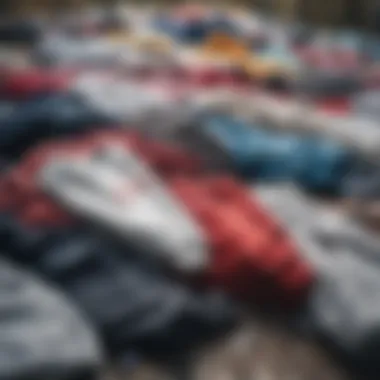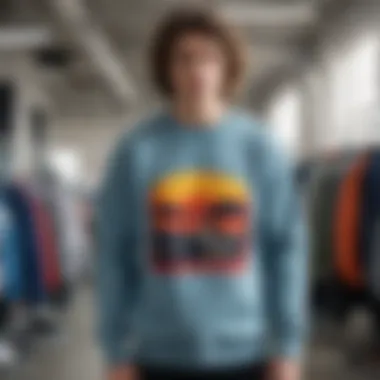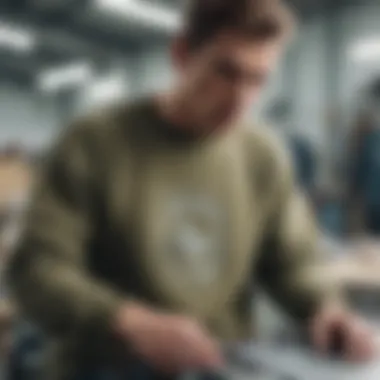The Lifecycle of a Sweatshirt: Recycling Benefits


Intro
The humble sweatshirt, often taken for granted, has a story that stretches far beyond its cozy embrace. Think about it: this essential piece of clothing journeys from the shops into our closets, often only to be cast aside when trends shift or wear sets in. This article dives into the lifecycle of sweatshirts, shedding light on the pressing issue of textile waste and the transformative power of recycling. The importance of reusing fabric cannot be emphasized enough, as it plays a pivotal role in diminishing the mountains of discarded clothing that clutter landfills. By dissecting the journey of a sweatshirt—from its initial purchase to its ultimate rebirth—we can glean insights on how we, as consumers, can champion a more sustainable future.
Understanding the recycling process begins with recognizing the materials that make our sweatshirts. Cotton blends, polyester, and other synthetic fibers can pose unique challenges when it comes to disposal. Each type of fabric presents its own set of considerations in terms of recycling viability and potential new applications. This article aims to equip you with the knowledge necessary to make informed decisions about your garments and their impacts on the environment.
As the textile industry grapples with changing consumer attitudes towards sustainability, innovative practices and recycling processes emerge. These range from upcycling old garments into fashionable new designs to initiatives that facilitate seamless cloth recycling across different textures. The industry is gaining traction, stepping towards accountability, and you’ll learn how you can participate and advocate for these developments.
So, let’s embark on this journey together, unraveling the lifecycle of a sweatshirt and uncovering the multifaceted benefits of recycling. Here’s what we’ll explore:
- The environmental effects of textile waste
- The step-by-step guide for recycling sweatshirts
- Creative transformations for repurposed materials
- The role of the industry in fostering sustainable practices
Ready to unwrap the practical magic hidden within that discarded sweatshirt?
“One person’s trash is another person’s treasure.”
Understanding Textile Waste
Textile waste is a pressing issue that has quietly crept into the fabric of our daily lives. As we indulge in the ease of fast fashion, the consequence of our choices becomes evident—landfills filled with discarded clothing, including sweatshirts. Understanding this waste is essential for realizing the broader implications on our environment and society. This segment will shed light on the importance of comprehending textile waste and its multifaceted impacts.
The Scale of the Problem
When you flip a sweatshirt inside out, you might notice a tag that reads 100% cotton or polyester. While the fabric choice matters, the real elephant in the room is how much of it is actually binned every year. The startling numbers suggest that the fashion industry produces roughly 92 million tons of textile waste annually. Most of this waste finds itself in landfills, where it takes years—even decades—to decompose.
To put it into perspective, it’s as if every person on the planet decides to discard a truckload of clothes yearly. That’s a staggering amount. The issues don’t stop with the sheer volume. It’s about what happens when these garments sit in landfills, slowly breaking down and releasing harmful chemicals into the soil and water.
Environmental Consequences
The environmental repercussions of textile waste are nothing to sneeze at. As clothing rots away, it releases greenhouse gases like methane—contributing to climate change. Moreover, the production process itself pollutes rivers and streams. Textile dyeing is notorious for its impact, with water quantities that can fill swimming pools being contaminated with toxic colors.
Moreover, many sweatshirts are made with synthetic materials that do not decompose easily. The microplastics that shed from our clothes during washing are washed into our oceans, causing harm to marine life. It’s a cycle that feeds on itself, perpetuating pollution and harming ecosystems.
"Every piece of clothing discarded not only adds to landfill waste but also defeats efforts to forestall the destruction of natural habitats."
Socioeconomic Impact
The issue doesn’t merely reside with environmental degradation but extends into economic and social realms. The fast fashion industry is predicated on cheap labor and often exploits workers in developing countries. When garments are tossed aside, they represent not just wasted resources but also wasted human effort.
Additionally, communities that rely on textile recycling approaches often face hurdles. With rising volumes of textile waste, local recycling facilities can become overwhelmed. Many people are left without easy access to recycling options, further exacerbating the problem. Not only does textile waste strain municipal budgets, but it also diminishes job opportunities in the recycling sector.
The Importance of Recycling Sweatshirts
Recycling sweatshirts is more than a trend; it’s a necessity in today's world. As our closets expand and the fast fashion wave surges, one cannot ignore the impact of textile waste on the planet. Throwing out an old sweatshirt seems harmless, but it contributes to a growing mountain of waste that fills landfills, pollutes the air, and harms natural resources. Recycling helps mitigate these effects, creating a more sustainable environment.
At the core, recycling offers numerous benefits that extend beyond waste reduction. It opens the door to resource preservation, preventing new raw materials from being extracted. This is particularly vital, considering the depletion of natural resources in the face of soaring global demand. By reusing what we already have, we not only lessen our ecological footprint but also support a circular economy, where products are continuously cycled through use and reuse.
Benefits of Recycling Textiles
Recycling textiles provides multiple advantages that enrich our communities and surroundings. Some of the primary benefits include:
- Conservation of Resources: Recycling sweatshirts reduces the need for virgin materials. This preservation saves trees, water, and energy.
- Job Creation: The recycling industry creates jobs related to sorting, processing, and transporting recycled materials. Local communities can thrive with these new opportunities.
- Reduction of Pollution: By recycling clothing, we can diminish the harmful pollutants released into the environment during the production of new fabrics.
These benefits underscore the substantial role recycling plays in shaping healthier ecosystems and vibrant communities.
Reducing Landfill Contributions
Every piece of clothing that winds up in a landfill contributes to the broader problem of waste management. Research shows that textiles can take years to decompose, leaching toxic substances into soil and groundwater as they break down. When sweatshirts are recycled instead of tossed out, they undergo processing that gives them a new lease on life.


- Space Saving: Landfills have limited capacity, and every item we recycle reduces the burden on these facilities.
- Sustainable Practices: It encourages the community to adopt more conscious consumer behaviors, promoting responsible disposal of textiles.
By actively choosing to recycle old sweatshirts, individuals champion landfill reduction and advocate for a cleaner, healthier environment.
Energy Savings from Recycling
Recycling isn’t just eco-friendly; it’s also an energy saver. In fact, it takes significantly less energy to recycle garments than to produce new ones. The process involves fewer stages—reducing the energy needed compared to transforming raw materials into finished products.
The difference in energy usage can be staggering:
- Cotton Production: Producing new cotton t-shirts requires a hefty amount of water and fossil fuels, whereas recycling the fabric utilizes what is already available, cutting down consumption.
- Lower Emissions: Recycling contributes to fewer greenhouse gas emissions. Less energy means fewer fossil fuels burned and less pollution created.
By recognizing the energy savings from recycling sweatshirts, we can steer toward a more sustainable future, where resources are utilized efficiently and responsibly.
"Recycling is a key component to a sustainable, circular economy, creating a pathway towards responsible consumption and production."
In essence, the act of recycling sweatshirts embodies a commitment to environmental consciousness, strengthens community ties, and paves the way for a healthier future. Understanding its importance is crucial for fostering a movement that champions sustainability, not just for ourselves, but for generations to come.
How to Recycle Your Sweatshirt
Recycling sweatshirts isn’t just an eco-friendly fad; it’s a crucial step in mitigating textile waste. With rapid trends in fashion, the lifespan of a sweatshirt often gets cut short. Yet, understanding the pathways for recycling can lead to considerable benefits, enriching both the environment and society.
Just think about it. That sweatshirt you wore through thick and thin can transform into something brand new, provided it finds the right recycling channels. The ultimate goal here is to breathe new life into fabric rather than letting it become just another piece in a landfill.
Identifying Recyclable Materials
First off, not every piece of clothing is created equal when it comes to recycling. Knowing what materials are recyclable can save you time and effort. Generally, sweatshirts made from cotton, polyester, or blended fabrics have better chances of being reused.
Look for labels or tags on your sweatshirt. Cotton, for instance, is a sustainable option and, when recycled, can become new fabric. Polyester, however, is a synthetic fabric. Here’s the trick: synthetic materials can be tricky. They might require special facilities for recycling.
- 100% Cotton: Often accepted in most recycling programs.
- Polyester Blends: Check locally; acceptance varies.
- Non-Recyclable Fabrics: Look out for those pesky mixed material blends, like spandex or certain synthetic fibers that are less likely to be recycled.
To toss or not to toss? That’s the question. When in doubt, check your local guidelines.
Finding Local Recycling Programs
Once you’ve sorted out what you can recycle, the next step is to find the right recycling programs. These can be as close as your neighborhood or as far as a dedicated collection center. Many cities have textile recycling facilities that accept a variety of materials. It’s worth a peek!
Local nonprofits or charities may also have programs in place. Organizations often hike up the amount of clothing their partners receive by running initiatives like clothing drives or collection bins. You can also browse community boards, both in real life and online, like those found on Reddit or Facebook.
- Local thrift stores: They often take unwanted clothes for resale or recycling.
- Municipal waste management: Some cities have specific curbside pickups for textiles – be sure to ask!
- Dedicated recycling centers: You’d be surprised how many cities have them dedicated fully to fabric and textiles.
Shipping Options for Donation
If local options seem scarce, think about mailing your sweatshirts to organizations that accept donations. Many national nonprofits offer such services, making it simple to send your clothing. It can feel like a drop in the ocean, but every little bit counts on the recycling front.
When preparing to ship, make sure your sweatshirt is clean and in good condition. Most organizations prefer items that still have a good amount of wear left in them.
Also, some companies partner with courier services to facilitate easier donation. Always scout for the organization’s specific mailing instructions on their respective websites.
- USPS or UPS: Check their rates; often affordable to ship a small packet.
- Prepaid shipping labels: Many larger organizations provide this, giving you a simple way to send in your donations without the hassle.
- Local Fundraisers: Some groups may also run collection drives at specific dates, making it an even simpler solution.
"Recycling is a chain reaction, you can give your clothing a second chance!"
So, whether it’s identifying materials, seeking local recycling programs, or taking advantage of shipping options, the steps to recycling your sweatshirt can be straightforward. With a bit of effort, you can contribute to a healthier planet and support sustainable practices.
Innovative Ways to Repurpose Sweatshirts


Repurposing sweatshirts opens a realm of creativity and sustainability that can’t be overlooked. Instead of letting your worn-out or outgrown sweatshirts languish in a landfill, transforming them into new products not only reduces waste but also adds a unique flair to your wardrobe or home. It fosters a sense of craftsmanship that can be both personally fulfilling and environmentally friendly. As we delve into the ways to give sweatshirts a second lease on life, consider how each project can channel your creativity while making a positive impact on our planet.
Creating Fashionable Items
Sweatshirts can be easily transformed into fashionable items that hold a distinctive style. Think about turning that oversized sweatshirt into a trendy crop top or a tote bag with an urban vibe. This not only repairs an item of clothing that may otherwise be tossed aside but creates wearable art that speaks to your individuality.
- Crop Tops: With a few snips and stitches, an oversized sweatshirt can become the perfect summer crop. Pair this with high-waisted jeans or shorts for a laid-back look.
- Sweatshirt Dresses: By removing the cuffs and adding a belt, a simple sweatshirt can morph into a chic, casual dress that works great for a day out.
Repurposing gives a chance to reimagine clothing that fits the current trends, all while showcasing a commitment to sustainable living.
Functional Home Goods
Beyond fashion, sweatshirts can serve functional purposes around the house. For instance, using old sweatshirts to create cushions or throws can add warmth and a sense of comfort to any living space.
- Cushions: By filling the body of the sweatshirt with stuffing or old fabric scraps, you can create unique cushions that not only add flair to your decor but also a splash of personal history.
- Blankets: Collecting several sweatshirts and sewing them together creates a cozy blanket perfect for snuggling during colder months.
Using repurposed materials for home goods transforms the mundane into something special, making your living environment a reflection of your values and creativity.
Unique Gifts and Crafts
Repurposing sweatshirts into gifts or crafts is a terrific way to make something personal. Handmade gifts carry a distinct touch that mass-produced options lack. Here are several ways to craft unique items:
- Personalized Gifts: Consider crafting a customized pillow or wall art using fabric paint on an old sweatshirt. It’s a thoughtful gesture that can resonate deeply with the receiver.
- Pet Accessories: Sweatshirts can easily become stylish pet beds or toys. This is especially useful for those who prioritize sustainable options for their beloved pets.
Handmade gifts created from repurposed sweatshirts not only hold sentimental value but also tell a story of creativity and environmental consciousness.
"Every stitch reflects an intention to give a new life to what was once deemed as waste."
Overall, repurposing sweatshirts not only showcases creativity, but it also emphasizes a broader commitment to sustainability. In a world where fast fashion reigns, this approach not only shifts consumer habits, but aligns personal values with environmentally responsible actions. This shift is essential for those of us who are looking for ways to be more mindful about what we wear, own, and gift.
The Role of Brands in Textile Recycling
As the textile industry continues to grapple with the challenges of sustainability, brands hold a unique position. Their influence is not just in what they produce, but in how they engage with the lifecycle of their products. This section delves into the various facets of how brands can and should contribute to textile recycling, underlining the importance of their roles for both environmental and economic betterment.
Corporate Responsibility Initiatives
Every day, consumers become more conscious of the impact their purchases have on the planet. Brands are recognizing this shift, leading many to adopt corporate responsibility initiatives. These initiatives aren't merely a marketing gimmick; they're a reflection of a commitment to sustainable practices.
Brands like Patagonia show that corporate responsibility can be at the very heart of a company's strategy. For instance, their Worn Wear program encourages customers to bring in old Patagonia gear for repair or resale, extending the life of the product and reducing waste.
Engaging in transparency about their supply chain practices also has a ripple effect. Brands that openly share their sourcing, manufacturing, and disposal methods build trust with consumers, who are more likely to support responsible companies.
- Benefits of integrating corporate responsibility initiatives include:
- Enhanced brand loyalty
- Increased consumer trust
- Positive environmental impact
- Differentiation in a competitive market
Innovative Recycling Technologies
Innovation isn’t just reserved for product design; it's making waves in recycling processes too. Many brands are investing in cutting-edge recycling technologies that transform textile waste into new fibers. This not only closes the loop in the clothing lifecycle but also reflects a deep commitment to sustainability.
For example, with the advent of chemical recycling technologies, brands can extract raw materials from used clothes. This means turning a discarded sweatshirt into a brand new fabric, while significantly reducing the need for virgin resources. Companies are also looking into innovative approaches like fiber-to-fiber recycling, which could revolutionize how we think about textile waste.
- Key advantages of these innovative technologies include:
- Reducing overall production costs in the long run
- Minimizing waste in landfills
- Generating new, eco-friendly products from old textiles
Comprehensive Take-Back Programs


Take-back programs present a practical solution for brands wanting to be proactive in their recycling efforts. These programs encourage consumers to return end-of-life products directly to the company, ensuring proper recycling and reducing waste.
Brands such as H&M have implemented take-back initiatives, allowing customers to return used garments in exchange for discounts on future purchases. This not only incentivizes consumers to recycle, but it also fosters a culture of sustainability. It's like getting paid to do the right thing; everybody wins.
- Benefits of comprehensive take-back programs include:
- Decreased volume of textile waste in landfills
- Recovery of materials for reuse in new products
- Reinforced brand reputation as a leader in sustainability
It is evident that brands have a significant role to play in the future of textile recycling. By embracing responsibility, investing in technology, and offering take-back programs, they can create a positive impact that resonates far beyond their immediate business models.
Consumer Awareness and Engagement
Consumer awareness and engagement play a crucial role in the recycling chain, especially when it comes to the lifecycle of sweatshirts. Understanding textile waste is not just an environmental concern; it touches on social responsibility and personal values. The more the public knows about textile waste, the better decisions they can make regarding their clothing choices and disposal methods. This engagement fosters eco-conscious behaviors that extend beyond just the act of recycling.
Educating Consumers about Textile Waste
One of the toughest challenges with textile waste is the general lack of awareness. Many people don’t think about their sweatshirts once they’re no longer worn. They simply toss them in the trash, blind to the harm this does to our planet. Education is key. Initiatives like workshops, online courses, and social media campaigns can spread the word about the volume of textile waste each year. For instance, statistics indicate that more than 92 million tons of textile waste are produced globally each year, with a significant portion being from discarded clothing like sweatshirts.
Furthermore, spreading tips on how to identify recyclable materials and where to find local programs can empower consumers to make better choices. Educating the masses transforms apathetic consumers into informed participants in the recycling conversation, changing behaviours that previously favored landfill disposal.
Supporting Responsible Brands
Supporting responsible brands can be a game changer in the quest for sustainable fashion. The power of purchase influences companies to adopt eco-friendly practices. It’s a ripple effect—when consumers align their wallets with their values, companies take notice and often pivot towards sustainable practices.
Brands with transparent supply chains, like Patagonia or Reformation, not only offer sustainable products but create a community that values ethical fashion. When consumers choose to invest in responsible brands, they signal to the entire industry that sustainability isn't just a passing trend but a fundamental expectation.
"Every dollar spent is a vote for the kind of world you want to live in."
Promoting Sustainable Consumption Practices
Promoting sustainable consumption practices enhances the efficacy of recycling efforts. Rather than buying several inexpensive sweatshirts that will be tossed after a few wears, choosing high-quality items that last longer makes a significant difference. This mentality shifts the focus from fast fashion to timelessness, meaning each purchase is more thoughtful.
Incorporating practices such as:
- Upcycling: Turning old sweatshirts into gym bags or cozy blankets.
- Secondhand Shopping: Supports local businesses and keeps clothing in circulation.
- Garment Care: Simple actions like proper washing and storing can extend the life of clothing.
These practices, when embraced at the community level, create a culture of sustainability that resonates far beyond personal habits. By promoting such behaviors, we not only reduce waste but also foster a sense of responsibility among consumers, making them active participants in a more sustainable future.
Future Trends in Sweatshirt Recycling
As we gaze into the crystal ball of recycling, it becomes clear that the future of sweatshirt recycling is bright and transformative. The global push towards sustainability has cultivated a fertile ground for innovation, giving rise to new ideas and practices that promise a more circular, responsible approach to fashion. The evolving landscape reflects not just these emerging trends but also illustrates the collective responsibility we share in reducing textile waste.
Advancements in Materials Science
New frontiers in materials science are increasingly altering the ways we think about textile recycling. Researchers are delving into bio-based fibers and polymers. These everyday fabrics are not just adaptable but also derive from renewable sources. A striking example to consider is the use of recycled PET bottles to create polyester fibers. This better utilizes waste already in circulation, keeping it out of landfills.
Innovations like chemical recycling are also making waves. This process breaks down fabrics into their original materials, allowing for the recreation of high-quality fibers. Unlike conventional recycling, where quality often diminishes, chemical recycling promises to maintain or even enhance the quality of the new products. It’s a gamechanger for the industry, potentially leading to a restoration of materials that have lost their luster after multiple uses.
Emergence of Circular Fashion
Circular fashion marks a pivotal shift in how we perceive the lifecycle of clothing, including sweatshirts. This approach emphasizes a system where products are designed with their end-of-life in mind, reducing waste at every turn. Brands are now starting to integrate practices that prioritize sustainability from the very inception of a garment. For example, using designs that can be easily disassembled for recycling or repair can significantly extend the life of an item.
Circular fashion encourages collaboration between consumers and brands. This partnership ensures that products are not just cast off but repurposed or recycled, creating a true circular economy. Some brands are launching take-back programs, where customers can return used garments for recycling or refurbishment. In return, they often receive discounts on future purchases, enforcing a cycle of responsible consumption.
The Rise of Community-Based Solutions
Communities are stepping up with grassroots initiatives that tackle textile waste on a local level. These community-based solutions embrace a collective spirit, uniting individuals in their aim to reduce waste while fostering local economies. For instance, community workshops may offer classes on how to repair or repurpose old sweatshirts, turning something old into new treasures.
Neighborhood swap meets and clothing exchanges are popping up as people find ways to refresh their wardrobes without the costly price tags associated with fast fashion. These events not only reduce waste but also encourage a sense of camaraderie—sharing stories behind clothes and fostering deeper community bonds.
Furthermore, technology enhances these local efforts. Platforms like Reddit or Facebook groups are sprouting, where users can share resources, tips, and swap their preloved items directly. These digital marketplaces foster responsible consumer behavior, erasing the stigma around secondhand clothing and contributing to environmental sustainability.
"To truly break free from the linear model, we must embrace an ethos of sharing and community, redefining how the industry connects with its consumers."
In summary, the future of sweatshirt recycling is illuminated by advances in materials science, the momentum of circular fashion, and a resurgence of community engagement. Embracing these trends not only mitigates the environmental impact but also shapes a more responsible consumer culture, paving the way for a sustainable fashion landscape.













